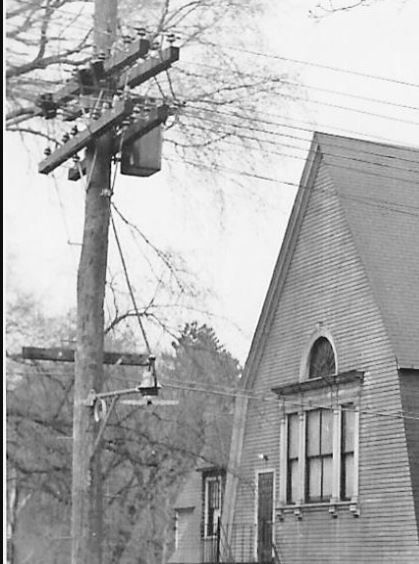Hingham Municipal Lighting Plant, MA, 1955. Single Unit Three Phase Pole Transformer.
By Joe Maurath, Jr.; posted October 15, 2020
View Original: Click to zoom, then click to magnify (419 x 564) 52KB

|
The growing trend during the 1950s and beyond for this utility and many others across the country was upgrading their primary circuits from 2,400 volt delta to 4,160 wye. This allowed a single entry into the latter-voltage transformer (compared to the older 2,400 delta units that required two) and provided additional supply in response to increasing customer needs. The transformer in this photograph was fairly new at the time. It was protected by three Kearney brown porcelain fuse cutouts also seen in the photo. These cutouts had a brown bakelite pull-handle door with a yellow plastic button on it denoting that the cutout was designed for "medium or intermediate duty" service. The compact design of this transformer provided three-phase customer connections via a single unit opposed to from three separately mounted ones. The town continued the forementioned conversion program into the early 1970s. The three phase primary lines throughout Hingham originated at separate substations utilizing 13,800 or 23,000 volt to 4,160 volt transformers. These were gradually replacing the older 2,400 volt ones along the town's streets, many units dating back to the 1910s. During this conversion Hendrix spacer cable was first installed in town during 1957 on rebuilt lines. Hingham, MA was one of the first utilities to utilize this type of primary construction. The first spreader insulators were constructed of somewhat fragile plastic, in two pieces and were transparent clear. Rubber grommets were set in between the two sections for running the wires through and a plastic nut and bolt in the middle held them together (photos of these insulators will follow in the near future). In 1960 the town specially ordered bright transparent green ones of the same design to blend in with its many historic tree-lined streets. In 1961 these insulators were one-piece, much more durable and solid gray. In addition to substation upgrades to 4,160 volt primary, additional substations were installed throughout town in keeping up with escalating commercial and residential growth along with new transformers in 1958 at the Tower Brook station replacing those installed in the 1930s. The town's substations were fed from the New England Electric System at 23,000 and 13,800 volts. New stations were built in the Industrial Park (1961), at the Cushing Street Operations Center (1961) and on Beal Street in 1966. All served the community extraordinarily well with superb reliability until the town converted to 13,800 volts primary in the late 1980s-early 1990s from the Hingham utility's 115kv station. The incandescent series street light in this photo was manufactured by the Wheeler Reflector Company and dates back to the 1920s-1930s. The series street lighting circuit wires in Hingham were identified on their crossarm via a glass pintype insulator supporting the series wire. Just about all of the other insulators in service for all other voltages had been porcelain pintypes for many years. By 1963 the town's three series street lighting loops connecting to their source in neighboring Weymouth, MA were removed after upgrading to multiple operation fixtures. These operated from a single photoelectric lighting control at 120 volts, mounted on the fixture or on the pole. Older series incandescent fixtures encountered in good condition were kept in the air by simply replacing the lightbulb socket with a multiple one and connecting it to its 120 volt lighting controller. Just above the street light is a lead-sheathed telephone subscriber cable supported lengthwise on a short crossarm. This method apparently was a Bell practice around here through the years. I believe by 1960 using crossarms as such was no longer necessary, especially since plastic covered cable was starting to catch on for telephone circuits. Those crossarms were built to last! They were creosote. Their braces were either 20-inches long or of similar length with a twist in them so that the pole lag screw for the brace was 90-degrees offset into the pole. I do not know what the advantage of such twisted braces were. Probably for additional strength? I am aware that using short crossarms for comms cables have been very commonplace on the West Coast for decades. |